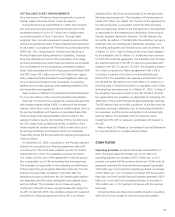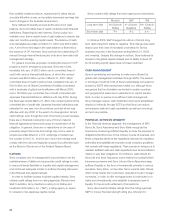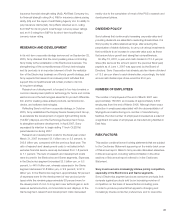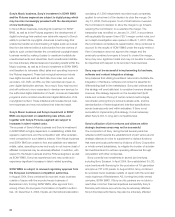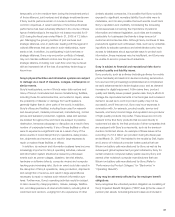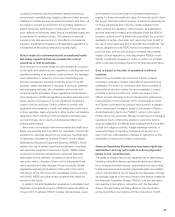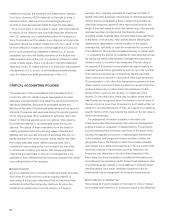Sony 2007 Annual Report Download - page 90
Download and view the complete annual report
Please find page 90 of the 2007 Sony annual report below. You can navigate through the pages in the report by either clicking on the pages listed below, or by using the keyword search tool below to find specific information within the annual report. 87
temporarily or in the medium-term during the investment period
of those alliances, joint ventures and strategic investments even
if Sony and its partners remain on course to achieve those
common objectives. A recent example of how Sony’s financial
performance has been adversely affected in the course of these
types of relationships is the equity in net losses recorded for S-
LCD during the fiscal year ended March 31, 2006 of 7.2 billion
yen. Managing the growing number of joint ventures and
strategic alliances, and, in particular, dealing with the legal and
cultural differences that can arise in such relationships, repre-
sents a risk. In addition, by participating in joint ventures or
strategic alliances, Sony may encounter conflicts of interest,
may not maintain sufficient control over the joint venture or
strategic alliance, including over cash flow, and may be faced
with an increased risk of the loss of proprietary technology or
know-how.
Sony’s physical facilities and information systems are subject
to damage as a result of disasters, outages, malfeasance or
similar events.
Sony’s headquarters, some of Sony’s major data centers and
many of Sony’s most advanced device manufacturing facilities,
including those for semiconductors, are located in Japan, where
the possibility of disaster or damage from earthquakes is
generally higher than in other parts of the world. In addition,
Sony’s offices and facilities, including those used for research
and development, material procurement, manufacturing, motion
picture and television production, logistics, sales and services
are located throughout the world and are subject to possible
destruction, temporary stoppage or disruption as a result of any
number of unexpected events. If any of these facilities or offices
were to experience a significant loss as a result of any of the
above events, it could disrupt Sony’s operations, delay produc-
tion, shipments and revenue, and result in large expenses to
repair or replace these facilities or offices.
In addition, as network and information systems have become
increasingly important to Sony’s operating activities, network
and information system shutdowns caused by unforeseen
events such as power outages, disasters, terrorist attacks,
hardware or software defects, computer viruses and computer
hacking pose increasing risks. Such an event could also result in
the disruption of Sony’s operations, delay production, shipments
and recognition of revenue, and result in large expenditures
necessary to repair or replace such network information sys-
tems. Furthermore, Sony’s operating activities could be subject
to risks caused by misappropriation, misuse, leakage, falsifica-
tion, and disappearance of internal information, including that of
customers and vendors. Judging from the experience of other
similarly situated companies, it is possible that Sony could be
exposed to significant monetary liability if such risks were to
materialize, and it is also possible that such events could harm
Sony’s reputation and credibility. Considering the increasing
social awareness concerning the importance of personal
information and relevant legislation, such risks are increasing
particularly for businesses that handle a large amount of
customer and consumer data. Although Sony continues to take
precautions against such unforeseen risks, such as by undertak-
ing efforts to educate operators and administrators who have
access to databases about appropriate ways to protect such
information, these measures may be insufficient, and Sony may
be unable to avoid or prevent such situations.
Sony is subject to financial and reputational risks due to
product quality and liability issues.
Sony products, such as software (including software for mobile
phone handsets) and electronic devices including semiconduc-
tors are becoming increasingly sophisticated and complicated
as rapid advancements in technologies occur, and as demand
increases for digital equipment. At the same time, product
quality and liability issues present greater risks. Sony’s efforts to
manage the rapid advancements in technologies and increased
demand, as well as to control product quality, may not be
successful, and if they are not, Sony may incur expenses in
connection with, for example, product recalls, service and
lawsuits, and Sony’s brand image and reputation as a producer
of high-quality products may suffer. These issues are not only
relevant to the final Sony products that are sold directly to
customers but also to the final products of other companies that
are equipped with Sony’s components, such as the semicon-
ductors mentioned above. An example of these issues is the
recording of a 51.2 billion yen provision during the fiscal year
ended March 31, 2007 that related to the recalls by Dell, Apple
and Lenovo of notebook computer battery packs that use
lithium-ion battery cells manufactured by Sony as well as the
subsequent global replacement program initiated by Sony for
certain notebook computer battery packs used by Sony and
several other notebook computer manufacturers that use
lithium-ion battery cells manufactured by Sony (Refer to
“Performance by Product Category” for “Electronics” in
“Operating Results”).
Sony may be adversely affected by its employee benefit
obligations.
Sony recognizes the unfunded pension obligation as consisting of
the (i) Projected Benefit Obligation (“PBO”) less (ii) the fair value of
pension plan assets. Actuarial gains and losses are included in


